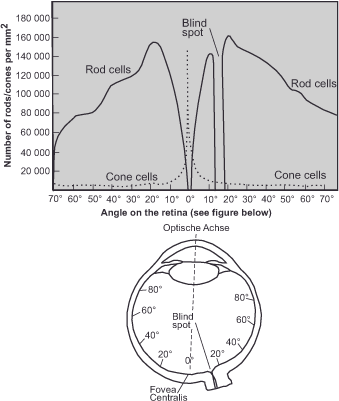You are here: Nature Science Photography – Visual acuity – The resolving power of the visual system
About 110 million rod receptors and just over 6 million cone receptors, not evenly distributed across the retina but concentrated in certain areas and more sparsely represented in others, occupy the retina. Three terms that are important in this context are fovea centralis, blind spot and retinal periphery. The
fovea centralis is located exactly in the line of sight, so that an object we fixate directly falls exactly on it. The blind spot is the place where the optic nerve leaves the retina, and the retinal periphery is the remaining area of the retina.


From figure 7 (Distribution of photoreceptors on the retina) we can see that the blind spot is the only place completely free of photoreceptors of both types and that the rod cells responsible for night vision are distributed over the retina in decreasing numbers from the inside to the outside. They reach their greatest density in a circle of 20° around the fovea and thus ensure sufficient optical resolution even at low illuminance. The number of rods remains relatively constant over the subsequent first half of the retina, before significantly decreasing towards the edge. The cone cells responsible for color daytime vision are conspicuously concentrated in the fovea centralis and are distributed in constant numbers over the retinal periphery from a position of 10°. From this we can deduce an important connection, because once you lift your gaze and fixate an object in your surroundings, you will certainly notice that you perceive this clearly, distinctly, and sharply, but that this distinctness and sharpness decrease rapidly towards the edge of the visual field. This sharpness impression distribution aligns with the distribution of photoreceptors, as we have recently determined, clearly indicating that the large number of cone receptors in the fovea centralis, where an object is directly fixed, must be the source of our sharpest visual impression. For this reason, let us confine the following consideration of our visual resolving power entirely to the cones.
The light-sensitive diameter of a cone is about 1.5 µm and the distance between the centers of two cones is about 2.5 µm. The fovea exclusively equips the particularly slender M and L cones, which are sensitive to the mid-wavelength and long-wavelength parts of the spectrum, respectively, to achieve this extraordinarily small distance. The reason for this lies in the problems posed by chromatic aberration (see chapter „Our preference for the warm colors“). The slightly broader S cones, whose sensitivity is limited to the short-wavelength spectrum, and of course the rod cells, are completely absent here.
We calculate the resolving power, which is determined by the arrangement of photoreceptors in the fovea, as follows: The focal length of the eye is almost exactly 25 mm. We divide the receptor distance of 2.5 µm by this 25 mm and obtain the value of 100 microradians (=0.0001 radians). One radian is (180/pi)*3600 = 206264.81 arcseconds. We multiply this value by 0.0001 radians and get 20.626481 arc seconds = 0.3437746 arc minutes = 0.0057295 degrees. The Rayleigh criterion only allows for half of this value, and further comparison confirms the impossibility of achieving more. Because if we take the theoretically maximum achievable resolution of αGrenz = 0.0105° as a basis, this means that the diffraction images of two point light sources must be at least 4 µm apart on the retina in order to be resolved. Due to their initial size, there are three cone receptors at this distance, which are sufficient to detect both the light sources and the dark area between them. A larger number of cones is unnecessary because they would resolve more details of the diffraction pattern but not of the light sources. Conversely, a smaller number of cones would not resolve the details contained in the retinal image. Thus, the retina’s structure almost perfectly adapts to the theoretically maximum achievable resolving power.
The radian (unit symbol: rad) is used to indicate the size of a plane angle. It is a derived unit in the SI system of units. The plane angle of 1 radian encloses an arc of length 1 meter on the circumference of a circle of radius 1 meter. The solid angle encompasses 2π radians: 1 solid angle = 2 π rad. (Wikipedia)
Next The neuronal circuitry of the photoreceptors
Main Visual acuity
Previous Diffraction as a physical limitation
If you found this post useful and want to support the continuation of my writing without intrusive advertising, please consider supporting. Your assistance goes towards helping make the content on this website even better. If you’d like to make a one-time ‘tip’ and buy me a coffee, I have a Ko-Fi page. Your support means a lot. Thank you!


 Since I started my first website in the year 2000, I’ve written and published ten books in the German language about photographing the amazing natural wonders of the American West, the details of our visual perception and its photography-related counterparts, and tried to shed some light on the immaterial concepts of quantum and chaos. Now all this material becomes freely accessible on this dedicated English website. I hope many of you find answers and inspiration there. My books are on
Since I started my first website in the year 2000, I’ve written and published ten books in the German language about photographing the amazing natural wonders of the American West, the details of our visual perception and its photography-related counterparts, and tried to shed some light on the immaterial concepts of quantum and chaos. Now all this material becomes freely accessible on this dedicated English website. I hope many of you find answers and inspiration there. My books are on